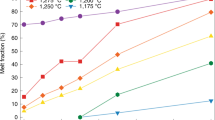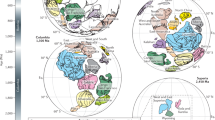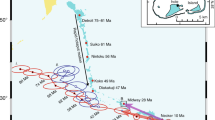Abstract
The geoid bears little relation to present tectonic features of the Earth other than trenches and hotspots. The Mesozoic supercontinent of Pangea, however, apparently occupied a central position in the Atlantic–African geoid high. This and the equatorial Pacific geoid high contain most of the world's hotspots1,2. The plateaus and rises which are now in the western Pacific formed in the Pacific geoid high and this may have been the early Mesozoic–late Palaeozoic position of a large part of Asia and other fragments of the Pacific rim continents. The major global geoid highs were regions of extensive Cretaceous volcanism and may be the former sites of continental aggregations and mantle insulation and, therefore, hotter-than-normal mantle. The pent-up heat causes rifts and hotspots and results in uplift, magmatism, fragmentation and dispersal of the continents and the subsequent formation of plateaus, aseismic ridges and seamount chains which cause a global rise in sea-level. Convection in the upper mantle caused by such lateral temperature gradients is intrinsically episodic. A geoid anomaly of 50 m can be formed in about 100 Myr by continental insulation. We show here that such geoid anomalies are long-lived and may be used to remove the ambiguity in early Mesozoic–late Palaeozoic plate reconstructions. Geoid highs control the rotation axis of the Earth and, in effect, bring long-lived continental aggregations to the Equator. Many aspects of continental geology such as vertical-tectonics and episodicity of magmatism and transgressions can be explained by continental insulation.
This is a preview of subscription content, access via your institution
Access options
Subscribe to this journal
Receive 51 print issues and online access
$199.00 per year
only $3.90 per issue
Buy this article
- Purchase on Springer Link
- Instant access to full article PDF
Prices may be subject to local taxes which are calculated during checkout
Similar content being viewed by others
References
Chase, C. Nature 282, 464–468 (1979).
Crough, S. & Jurdy, D. Earth planet. Sci. Lett. 48, 15–22 (1980).
Morgan, W. J. in The Sea Vol. 7 (ed. Emiliani, C.) 443–488 (Wiley-Interscience, New York 1981).
Cochran, U. & Talwani, M. Geophys. J. 50, 495–552 (1977).
Menard, H. & Dorman, L. J. geophys. Res. 82, 5329–5335 (1977).
Kanasewich, E. R., Havskov, J. & Evans, M. Can. J. Earth Sci. 15, 919–955 (1978).
Pollack, H. & Chapman, D. S. Tectonophysics 38, 279–296 (1977).
Watts, A. B., Bodine, V. & Ribe, N. Nature 283, 532–537 (1980).
Schlanger, S. O., Jenkyns, H. C. & Premoli-Silva, I. Earth planet. Sci. Lett. 52, 435–449 (1981).
Vail, P., Mitchum, R. M. Jr & Thompson, S. III Am. Ass. petrol. Geol. Mem. 26, 83–97 (1978).
McElhinny, M., Embleton, B. J. J., Ma, X. H. & Zhang, Z. K. Nature 293, 212–216 (1981).
Panuska, B. & Stone, D. Nature 293, 561–563 (1981).
Hattori, I. & Hirooka, K. Tectonophysics 57, 211–235 (1979).
Hammond, S., Kroenke, L., Thayer, F. & Keelong, D. Nature 255, 46–47 (1975).
Larson, R. & Chase, C. Bull. geol. Soc. Am. 83, 3627–3644 (1972).
Batiza, R., Larson, R., Schlanger, S., Scheka, S. & Tokuyama, H. Nature 286, 476–478 (1980).
Burke, K., Fox, D. & Senqor, A. M. J. geophys. Res. 83, 3949–3954 (1978).
Smith, A. G., Hurley, A. M. & Briden, J. C. Phanerozoic Paleocontinental World Maps (Cambridge University Press, 1981).
Boucot, A. J. & Gray, J. in Historical Biogeography, Plate Tectonics, and the Changing Environment (eds Gray, J. & Boucot, A. J.) 465–482 (Oregon State University Press, 1979).
Goldreich, P. & Toomre, A. J. geophys. Res. 74, 2555–2567 (1969).
Menard, H. W. Earth Planet. Sci. Lett 20, 237–241 (1973).
Dahlen, F. A. (in preparation).
Hager, B. H. (in preparation).
Sclater, J. G., Parsons, B. & Jaupart, C. J. geophys. Res. 86, 11,535–11,552 (1981).
Elder, J. Nature 214, 657–660 (1967).
Ichiye, T. J. geophys. Res. 76, 1139–1153 (1971).
Busse, F. J. Geophys. J. R. astr. Soc. 52, 1–12 (1978).
Froidevaux, C. & Nataf, H. Sonderdruck aus der Geologischen Rundschau Band 70, 166–176 (1981).
Gordon, R. G., McWilliams, M. O. & Cox, A. J. geophys. Res. 84, 5480–5486 (1979).
Van Alstein, D. R. thesis, California Inst. Technol. (1979).
Gordon, R. & Cape, C. Earth planet. Sci. Lett. 55, 37–47 (1981).
Jurdy, D. J. geophys. Res. 83, 4989–4994 (1978).
Author information
Authors and Affiliations
Rights and permissions
About this article
Cite this article
Anderson, D. Hotspots, polar wander, Mesozoic convection and the geoid. Nature 297, 391–393 (1982). https://doi.org/10.1038/297391a0
Received:
Accepted:
Issue Date:
DOI: https://doi.org/10.1038/297391a0
This article is cited by
-
Plate tectonics in the Archean: Observations versus interpretations
Science China Earth Sciences (2024)
-
The Paleozoic Central Patagonian Igneous Metamorphic Belt: its geodynamic and tectonic interpretation based on paleogeographic reconstructions
International Journal of Earth Sciences (2023)
-
Mantle plumes and their role in Earth processes
Nature Reviews Earth & Environment (2021)
-
The supercontinent cycle
Nature Reviews Earth & Environment (2021)
-
Weak orogenic lithosphere guides the pattern of plume-triggered supercontinent break-up
Communications Earth & Environment (2020)
Comments
By submitting a comment you agree to abide by our Terms and Community Guidelines. If you find something abusive or that does not comply with our terms or guidelines please flag it as inappropriate.



